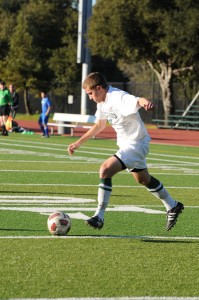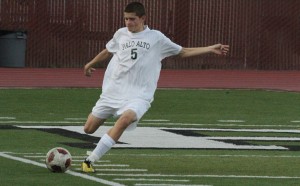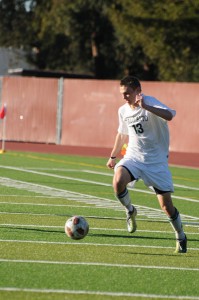From being ranked 13th in the nation to being on the verge of getting dropped to the lowest division of its league, Palo Alto high school boys’ varsity soccer has seen it all.
Only three years ago, the 2008-2009 team piled up a record of 21-1-3 en route to a Central Coast Section (CCS) co-championship it shared with Bellarmine, and Paly soccer’s first ever national ranking. It was the ultimate team, made up not of stars, but of a group of players who had played together for years and would do anything required to help their team win.
“It was just a special chemistry on that team, and there was a belief that we could go into every game and win it, and have fun doing it,” center midfielder Adam Zernik (‘09), who currently plays soccer at the University of California San Diego, said.
This all-for-one mentality was especially evident on the defensive end. The Vikings allowed only one goal during the entire league season, an average of .08 per game.
Compare that to the winless 2011-2012 squad, which gave up eight goals through its first three league games, a per game average over 30 times higher than the winning squad. In only three years, the program has dropped from the top of CCS to the cellar of the Santa Clara Valley Athletic League (SCVAL) De Anza division.
The main problem: Returning players, or, more specifically, the lack thereof. Head coach Don Briggs had only one returning player this year, Geraldo Neto (‘12), after varsity mainstays Geritt van Zyll (‘12), Kris Hoglund (‘12), Skyler Felt (‘13), Grant Shorin (‘13), Peter Laminette (‘13), Josh Totte (‘14) and a few other players all decided to quit for varying reasons. Then, the day before the last game, Neto quit too. The term “rebuilding year” does not even begin to describe the situation faced by Briggs and this year’s team.
“It’s a whole new team. We have more freshmen and sophomores than we do upperclassmen. It’s almost like a hybrid varsity-JV team,” Briggs said.
The young team has been struggling this year, amassing a league record of 0-8-2.
Although it is relatively common throughout high school for students to stop playing sports, the sheer number of standout athletes quitting the varsity soccer team this year begs the question: Why?
Each athlete has his own unique reasons for opting to discontinue his varsity soccer career, but there were several common threads among the rationale they provided. Three leading factors emerged: Club team conflicts, injuries and friction with the coaching staff.
For Laminette and Totte, the decision to quit Paly sports boiled down to a choice between a club team and the high school team. While some accommodating club teams allow their players to participate with both, others are not as willing.

De Anza Soccer Club coach Bob Joyce explained the reasoning behind these regulations.
“They want the players 100% to themselves,” Joyce said. “I think that in terms of high school coaching the level of play is inferior and the result is the player takes a step backwards in terms of how well they play the sport.”
Totte plays for the Earthquakes Academy, a club team connected with Youth National Teams. The Academy does not permit its athletes to play for their high school teams, so the choice to play forced Totte to cut his varsity soccer career short.
“Academy gives you a lot of exposure and it’s really good competition,” Totte said. “I didn’t want to give that up in order to play high school [soccer].”
However, club team-imposed restrictions were not the only difficulties faced by prospective returning players. In the case of several ex-Paly soccer players, it was Briggs’ own rules that prevented them from joining the team. Briggs requires Paly players to attend all of the preseason practices and games without exception. This rule was especially relevant for those who intended to miss the high school preseason to play club soccer.
“[Shorin, van Zyll, and I] weren’t allowed [by Briggs] to play [Paly soccer] because we missed preseason, during which time we played with my club soccer team and competed in two national showcases,” Laminette said.
Laminette values the opportunities that his club team provides, and feels that giving up the high school sports experience is worth the sacrifice.
“I don’t have any regrets,” he said. “I think the trade-off between Paly soccer and club soccer was definitely worth it because of the exposure I got to college coaches.”
Athletic director Earl Hansen feels that the conflict between club and school teams is an unfortunate reality in the world of soccer.
“I don’t like it at all, I don’t like the situation,” Hansen said. “No other [club] sport does that; they never interfere with the high school season.”
According to Hansen, a new policy regarding the club and high school team conflict will be in action for the 2012-2013 season.
“The rule now that is in effect for the next season is that the Monday after Thanksgiving is when you have to decide if you are going to play high school or not,” Hansen said.
He added, however, that for this season, “there was not a rule.”
In addition to the difficulty of balancing high school sports with club team requirements, injuries also claimed the careers of Hoglund and Fede Clerici (‘12), two of would-be returning players.
Hoglund broke his leg as a goalie during the 2010-2011 season. Though recovered enough to play in the 2011-2012 season, Hoglund decided not to play again.
“Coming back, [I] wasn’t totally ready for the season, and figured that the risk wasn’t worth it because my top sport is lacrosse,” Hoglund said.
Hoglund was not alone in suffering a debilitating injury during his high school career; midfielder Clerici broke his back after his season as a freshman on the varsity team.
Regardless of his career-ending injury, Clerici is not convinced that he would have returned to the team this year anyway.
“If I wasn’t injured, I wouldn’t have played Paly soccer [because of] Briggs,” he said. “I feel like the rest of the team quit because of Briggs.”
The experience van Zyll faced offers significant evidence to support Clerici’s suggestion. He had planned to return to the team this year after the end of his club season, but prior club soccer engagements would prevent him from joining the Paly team during the preseason.

“I went to [Briggs] and told him about [missing preseason] on the first day of tryouts and he said that [there was a] rule that you weren’t allowed to miss preseason and then play,” van Zyll said. “But a couple of weeks later, I found out that it wasn’t a rule.”
The aforementioned rule, California Interscholastic Federation (CIF) Bylaw 600, states that athletes are prohibited from competing on other teams during the season. However, van Zyll only intended to compete on his club team during the preseason, an important technical distinction that would not have violated the rule.
The original misunderstanding between coach and player gave way to the root of the conflict, which in Briggs’ mind was an issue of fairness.
“How fair is it for players who’ve been playing since October 30 at tryouts to be told they aren’t needed anymore?” Briggs asked.
Hansen also finds fault with allowing club players to join the team after preseason.
“I would have a lot of problems if my son or daughter was out there practicing for a month and a half and someone starts over them,” Hansen said. “That’s not fair.”
Hoglund offered an alternative view point.
“I think it was unfair to the other players because now they don’t have these really good players coming back to help the team,” Hoglund said.
When Briggs informed van Zyll that he would not be able to play on the team, van Zyll was disappointed to learn that his entire season would be lost.
“I was kind of bummed that I was going to be missing the high school soccer [season],” van Zyll said. “It wasn’t my choice.”
Zernik sympathizes with van Zyll’s plight.
“That kind of sucks for [the players who aren’t playing],” Zernik said. “[They are] missing high school soccer, which can be a pretty magical experience.”
Unfortunately, van Zyll was not the only one to struggle with club conflicts and coaching disagreements. Just as athletes are required to build a working chemistry with their teammates, a certain level of understanding is required between player and coach. When that understanding fails to appear, it makes the season difficult for both sides.
“High school sports are pretty tense when it comes to player-coach relationships because everyone’s after playing time, while people who aren’t playing don’t think the coach knows what he’s doing,” Zernik said.
However, Hoglund believes that Briggs’ coaching style has more to do with the quitting than simply the natural player-coach stress in high school.
“Coach Briggs has a very authoritative style that doesn’t work with a lot of players,” Hoglund said. “This year he lost a lot of players because he wouldn’t adjust his rules to accommodate people.”
These people included van Zyll and Laminette with their club team, and Felt, who so strongly opposed the the coaching style that he felt unable to stay on the team.
“I’m not playing Paly soccer because last year I did not enjoy my stay on the team,” Felt explained. “Briggs and I did not get along well.”
Felt ended his high school career after enduring a frustrating 2010-2011 season.
“I decided after last season that I didn’t want to come back because of how much I didn’t like it,” Felt said. “[Briggs and I] didn’t see eye to eye on many things: Mainly my style of play, my positioning and his coaching philosophy compared to what I’m used to.”
Briggs has been coaching the varsity team since the 2003-2004 season; however this is the first time that such a great number of players have chosen to discontinue their varsity careers.
“It used to work well because the players were really good despite what he did, but now its sort of backfiring on him and he’s lost some players, so it’s not working as well,” Hoglund said.
However, Zernik’s personal experiences with Briggs refute Hoglund’s opinion.

“I understand that’s changed a lot since I graduated; if we were playing for the equivalent team we wouldn’t [have been] able to play high school soccer,” Zernik said. “I think Briggs was the perfect coach for our team [that] year.”
Co-captain Alex Chin (‘13) finds no fault with his coaching.
“I think he knows what he’s talking about, he has a lot of experience,” Chin said.
Team co-captain Kirby Gee (‘13), a first year varsity player, sympathizes with both sides and has no problem with either.
“I understand how they don’t like [Briggs] but I personally like him,” Gee said.
Other players, like Paul Mewes (‘15) appreciate the opportunity to gain experience at a young age by getting more playing time than they would have with more returning players. He, like Gee and other players who stuck with the team, supports
Briggs and appreciates his style.
“He’s a good coach and it’s fun playing for him,” Mewes said. “I definitely think it’s helping me and the other freshmen improve a lot.”
The decision to quit a team belongs first and foremost to the player, but the impact of the decision goes deeper than that. No matter the reason, losing a player creates a void on the team, so quitting should not be decided without thorough consideration of all the consequences. Special attention must be paid to the effect on one’s teammates. Neto, for example, was impacted to the point of quitting.
“[It’s] disappointing,” Neto said. “We lost a lot of great players [and] a lot of talent. We could [have been] so much better this year if we had them back.”
As Gee puts it, the team has come to accept the reality it faces this season, and attempts to maintain a positive attitude in the face of near-constant adversity.
“It’s not that we know we are going to lose every game, but we sort of understand our losses, so we try not to get down on ourselves when we lose games,” Gee said.
Yet even with a positive attitude, constant losses eventually wear down any athlete. When everything is said and done, the 2011-2012 season is one full of regrets for nearly all parties involved. From club conflicts to coach conflicts to unavoidable injuries, the record speaks for itself.
And, adding insult to injury, as van Zyll puts it, “The whole thing could have been avoided.”



